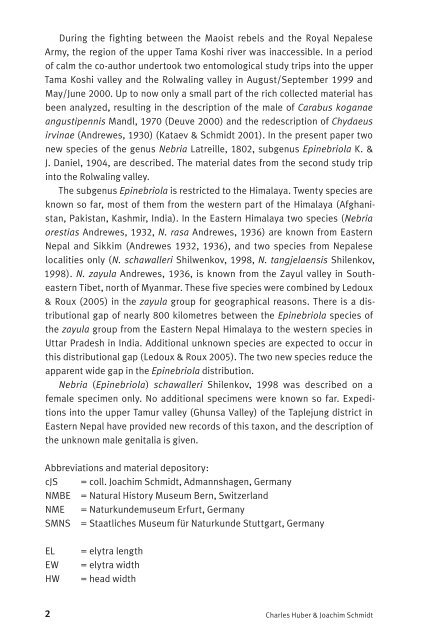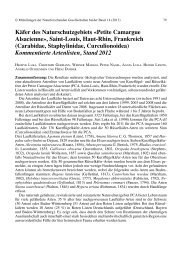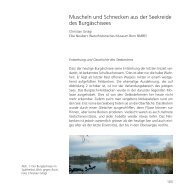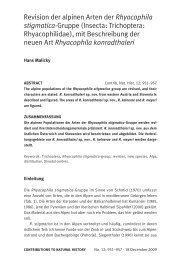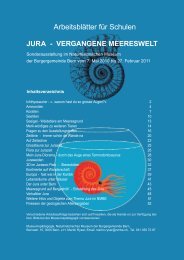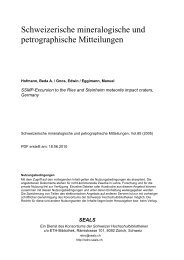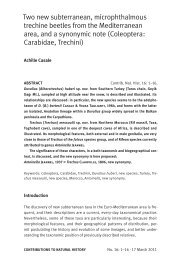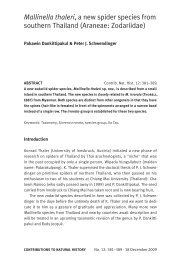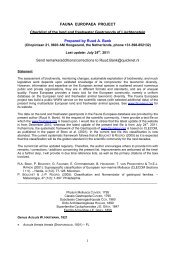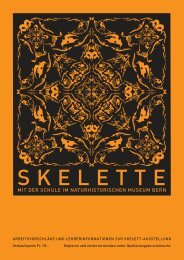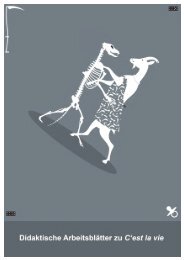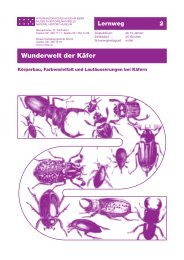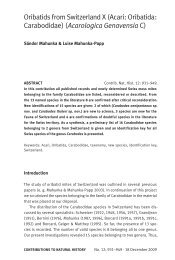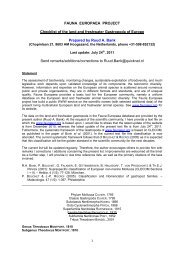Nebria - Naturhistorisches Museum Bern
Nebria - Naturhistorisches Museum Bern
Nebria - Naturhistorisches Museum Bern
Erfolgreiche ePaper selbst erstellen
Machen Sie aus Ihren PDF Publikationen ein blätterbares Flipbook mit unserer einzigartigen Google optimierten e-Paper Software.
During the fighting between the Maoist rebels and the Royal Nepalese<br />
Army, the region of the upper Tama Koshi river was inaccessible. In a period<br />
of calm the co-author undertook two entomological study trips into the upper<br />
Tama Koshi valley and the Rolwaling valley in August/September 1999 and<br />
May/June 2000. Up to now only a small part of the rich collected material has<br />
been analyzed, resulting in the description of the male of Carabus koganae<br />
angustipennis Mandl, 1970 (Deuve 2000) and the redescription of Chydaeus<br />
irvinae (Andrewes, 1930) (Kataev & Schmidt 2001). In the present paper two<br />
new species of the genus <strong>Nebria</strong> Latreille, 1802, subgenus Epinebriola K. &<br />
J. Daniel, 1904, are described. The material dates from the second study trip<br />
into the Rolwaling valley.<br />
The subgenus Epinebriola is restricted to the Himalaya. Twenty species are<br />
known so far, most of them from the western part of the Himalaya (Afghanistan,<br />
Pakistan, Kashmir, India). In the Eastern Himalaya two species (<strong>Nebria</strong><br />
orestias Andrewes, 1932, N. rasa Andrewes, 1936) are known from Eastern<br />
Nepal and Sikkim (Andrewes 1932, 1936), and two species from Nepalese<br />
localities only (N. schawalleri Shilwenkov, 1998, N. tangjelaensis Shilenkov,<br />
1998). N. zayula Andrewes, 1936, is known from the Zayul valley in Southeastern<br />
Tibet, north of Myanmar. These five species were combined by Ledoux<br />
& Roux (2005) in the zayula group for geographical reasons. There is a distributional<br />
gap of nearly 800 kilometres between the Epinebriola species of<br />
the zayula group from the Eastern Nepal Himalaya to the western species in<br />
Uttar Pradesh in India. Additional unknown species are expected to occur in<br />
this distributional gap (Ledoux & Roux 2005). The two new species reduce the<br />
apparent wide gap in the Epinebriola distribution.<br />
<strong>Nebria</strong> (Epinebriola) schawalleri Shilenkov, 1998 was described on a<br />
female specimen only. No additional specimens were known so far. Expeditions<br />
into the upper Tamur valley (Ghunsa Valley) of the Taplejung district in<br />
Eastern Nepal have provided new records of this taxon, and the description of<br />
the unknown male genitalia is given.<br />
Abbreviations and material depository:<br />
cJS = coll. Joachim Schmidt, Admannshagen, Germany<br />
NMBE = Natural History <strong>Museum</strong> <strong>Bern</strong>, Switzerland<br />
NME = Naturkundemuseum Erfurt, Germany<br />
SMNS = Staatliches <strong>Museum</strong> für Naturkunde Stuttgart, Germany<br />
EL = elytra length<br />
EW = elytra width<br />
HW = head width<br />
2 Charles Huber & Joachim Schmidt


